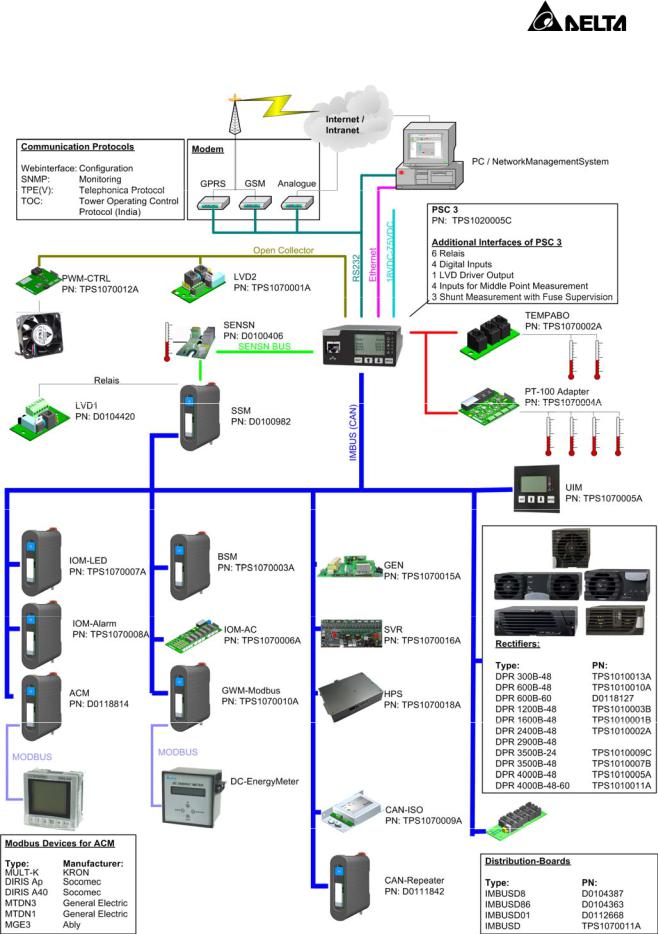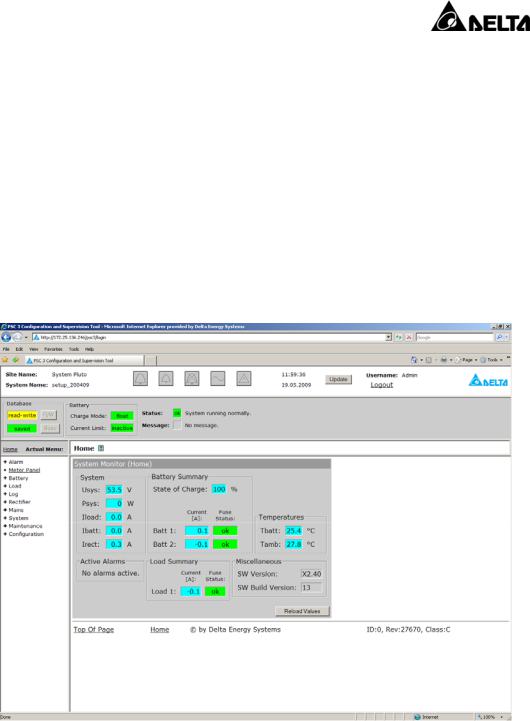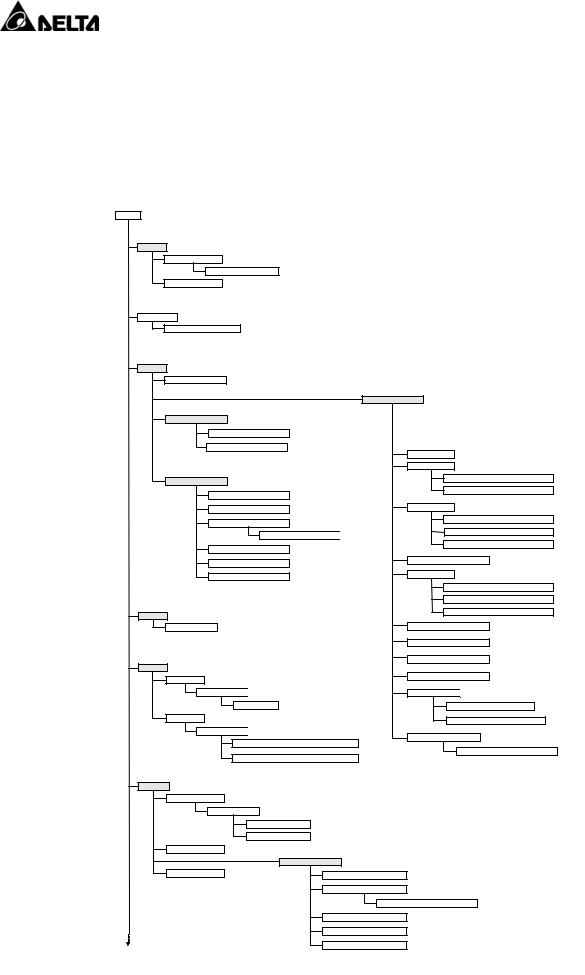DELTA PSC 3 User Manual

User manual
Product description Controller PSC 3
3791133000_02

Table of contents
1 About the Delta PSC 3 controller ....................................................................... |
2 |
||
2 |
Features overview .............................................................................................. |
4 |
|
3 |
Functional overview............................................................................................ |
5 |
|
|
3.1 |
Battery functions ...................................................................................... |
5 |
|
3.2 |
Source string function .............................................................................. |
5 |
|
3.3 |
Rectifier functions..................................................................................... |
6 |
|
3.4 |
Signal processing engine......................................................................... |
6 |
|
3.5 |
AC measurement function........................................................................ |
6 |
4 |
User interfaces ................................................................................................... |
7 |
|
|
4.1 |
Web user interface ................................................................................... |
7 |
|
|
4.1.1 Web user interface menu........................................................... |
8 |
|
4.2 |
Local user interfaces .............................................................................. |
12 |
5 |
Physical connections........................................................................................ |
13 |
|
6 |
Modules ............................................................................................................ |
14 |
|
|
6.1 |
User Interface Module UIM1 .................................................................. |
14 |
|
6.2 |
String Sensor Module SSM.................................................................... |
15 |
|
6.3 |
Block Voltage Sensor Module BSM ....................................................... |
16 |
|
6.4 |
Remote Alarm Board IOM-ALARM ........................................................ |
17 |
|
6.5 |
LED Driver Board IOM-LED ................................................................... |
18 |
|
6.6 |
Input/Output Module IOM-AC................................................................. |
19 |
|
6.7 |
Healthy Phase Selector HPS ................................................................. |
20 |
|
6.8 |
AC Measurement Gateway Module ACM1 ............................................ |
21 |
|
6.9 |
Gateway Module GWM-MODBUS......................................................... |
22 |
|
6.10 |
CAN Repeater Module IMBUSR1.......................................................... |
23 |
|
6.11 |
CAN Isolation Module CAN-ISO ............................................................ |
24 |
|
6.12 |
Generator Control Module GEN............................................................. |
25 |
|
6.13 |
Static Voltage Regulator Module SVR ................................................... |
26 |
|
6.14 |
PT100 Temperature Sensor Adaptor..................................................... |
27 |
|
6.15 |
Fan Speed Controller PWM CTRL......................................................... |
28 |
|
6.16 |
SENSN device ....................................................................................... |
29 |
Product description, Controller PSC 3 Table of contents

1 About the Delta PSC 3 controller
This document has been created for PSC 3 software version 2.6x. The document is updated only when necessary when new software versions are released.
PSC 3 is a sophisticated power system controller that can be used for both small and very large, complex power systems. It consists of a single central unit, which provides basic I/O periphery. A very robust and reliable CAN standard-based communication bus (IMBUS) provides easy expansion.
PSC 3 uses external modules for monitoring system elements. This modular approach is perfect for expandable power systems with decentralized distributions (BDFB) and batteries in separate rooms. The integrated PLC offers the flexibility for monitoring and control of auxiliary devices, system upgrades, and capacity expansions.
The enhanced system functions provided by PSC 3 help reduce operating costs and improve availability. Battery management, for example, is one of the key factors for the availability of a power system. Regular capacity tests by PSC 3 significantly improve battery management. PSC 3 also allows remote alarms by means of potential-free relay contacts, modem, or LAN/Ethernet or via SMS. The SNMP functionality offers enhanced remote alarms working with SNMP managers. The alarms are classified as critical, urgent or non-urgent alarms.
An integrated web server offers a user-friendly graphical interface for detailed monitoring and control using a web browser. The PSC 3 can be accessed from virtually anywhere, over intranet or Internet, or by modem. The user interfaces can be localized, supporting up to two additional languages besides English.
2 |
Product description, Controller PSC 3 About the Delta PSC 3 controller |

Figure 1. PSC 3, the heart of a modular power system
Product description, Controller PSC 3 About the Delta PSC 3 controller |
3 |

2 |
Features overview |
|
The key features of a PSC 3 system include: |
•Modular concept: PSC 3 can be customized for both small and large systems
•Flexible setup and supervision of battery-, sourceand load strings
•Remote system supervision over intranet, Internet and modem
•Remote software update of system components
•AC mains voltage measuring without external equipment PSC 3 offers the following features:
•Local system monitoring and basic setup with display, keypad and 5 alarm LEDs
•Flexible event processing for alarm management
•3 Alarm levels: Critical, Urgent, Non-urgent
•Localization of user interface, supporting up to two additional languages
•Ethernet interface to PC or LAN
•Modem or RS 485 interface
•3 inputs for shunt measurement, current and fuse supervision
•4 inputs for battery middle point measuring
•2 RECTS interfaces
•2 IMBUS interfaces using CAN bus
•6 digital relay outputs (changeover contacts, pluggable clamp connection)
•4 digital open collector outputs
•4 digital inputs
•2 inputs for temperature sensors
•Real time clock
•LVD driver relay output
•DHCP server and auto-detect of Ethernet cable type for easy connection to a computer
Additional HW and/or SW components extend the range of features to include:
•Expandable number of voltage measurements for battery blocks
•Rectifier positioning
•Expandable number of battery- / load- / source-strings (current, voltage, temperature, fuse supervision)
•Expandable number of relay outputs for alarms or LVD/LVLD
•Expandable number of LED outputs for alarm or status indications
•Expandable number of digital inputs with individual threshold and hysteresis
•2 local user interface modules with additional buzzer (UIM)
•AC measurement with external module (3-phase voltage, current, frequency, power, energy)
•Genset control including measurement of AC output parameters
•Static voltage regulation vie SCR drivers / multiple tap transformer
•Healthy phase selector
•Speed control for cooling fans of outdoor cabinets or containers
•RS-485/Modbus interface to communicate with DC energy meters
•SNMP for reporting events to a network supervision device
•Forwarding alarms via SMS
4 |
Product description, Controller PSC 3 Features overview |

3 Functional overview
The main task of the system controller is to enhance the reliability and lower the operating and maintenance costs by:
•Controlling the rectifiers to run at the highest efficiency.
•Extending the battery life time by providing the best possible conditions.
•Informing the user in case interventions are needed and providing the necessary information for corrective actions.
3.1Battery functions
The system controller includes the following charge functions, with or without temperature compensation:
•Float charge
•Boost charge
•Equalize
•Event controlled charge (for example, generator set usage)
The test functions include:
•Constant current, capacity, real load, and time based battery tests
•Natural battery test (using the opportunity of a mains failure)
•Separate discharge/charge of a battery
The protection functions include:
•Disconnection (due to low voltage or mains failure plus delay)
-Battery disconnection
-Full and partial load disconnection
•Charging current limitation
The supervision functions include:
•Loss of back-up time
•Middle point voltage supervision
•String current comparison
•Block voltage measurement
3.2Source string function
The current from solar converters and wind generators can be measured by shunts in socalled source strings and such upgrading a power plant to a RHPS (Renewable Hybrid Power System).
Product description, Controller PSC 3 Functional overview |
5 |

3.3Rectifier functions
The control functions include:
•Efficiency mode – optimizes the system for efficiency, switches off unused rectifiers, and so on
•Forced rectifier cycling - balancing the operation time of rectifiers The supervision functions include:
•Redundancy supervision – alerts if there is no redundant rectifier
•Recharge power supervision – alerts if there is not enough power to recharge battery within specified time
3.4Signal processing engine
PSC 3 has a built in Signal Processing Engine, which allows defining reactions to react to events initiated by specified parameter changes. The user may define as many events as needed on all digital inputs as well as on measurements, such as voltage, current, and temperature using signal conditioning. Events may be combined using logical functions AND, OR, Boolean inversion, signal filtering, latching events, and timer events.
3.5AC measurement function
PSC 3 measures basic mains voltages using the connected rectifiers. The measured values can be viewed via local and / or web user interface:
• Phase-Neutral voltages
The optional HPS module can be used to measure the parameters of the AC network:
•Phase-Neutral and Phase-Phase voltages
•Currents
•Apparent power
•Active power
•Energy
•Frequency
With the ACM1 Gateway Module it is possible to connect a commercial 3 phases
AC-measurement device, providing more AC information:
•Phase-Neutral and Phase-Phase voltages
•Currents
•Active power
•Frequency
•Power factor
The measured values are visible via local / web user interface, too.
6 |
Product description, Controller PSC 3 Functional overview |

4 |
User interfaces |
4.1Web user interface
An integrated web server provides the interface for monitoring and controlling the power system by a computer with a standard web browser.
The PSC 3 Configuration and Supervision Tool offers flexible and comprehensive configuration and supervision functions for power systems. It can be operated by almost all common web browsers. Access to controller and system functions is provided with user and session management features.
Figure 2. PSC 3 Configuration and Supervision Tool
The Navigation Bar on the left is used to navigate through the dialogue pages:
•Click on „+“ to expand the desired menu.
•Click on „• xxxxx“ to access the desired function / window.
•Click on „?“ to get online help to the active window
•Click on „-“ to collapse the menu.
Product description, Controller PSC 3 User interfaces |
7 |

4.1.1Web user interface menu
Some dialogues are not visible in the navigation bar. These ones are accessible via other dialogues only and are marked in the following figures (*).
Figure 3. Web user interface menu part 1
8 |
Product description, Controller PSC 3 User interfaces |
